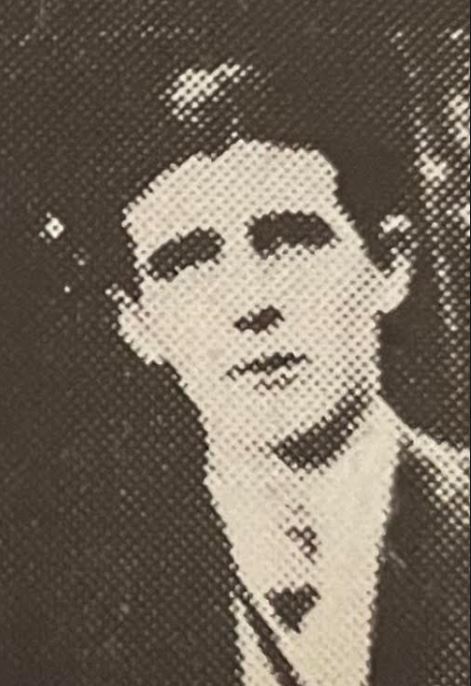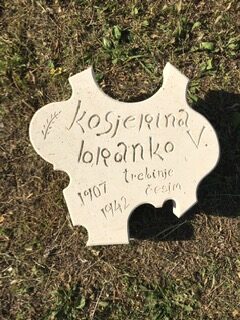
brochure "Partizanski spomenik u Mostaru" (1980)
book “Spomenica Mostara 1941-1945.”
another document or proof of the memorial stone (e.g., a photograph).
Branko V. KOSJERINA
BRANKO KOSJERINA, son of VLADIMIR, born on April 3, 1907, in Trebinje. He had a half-sister Radojka, a brother Milenko and a sister Ranka who died as children, and brothers Slavko and Nedeljko. Clerk. Father Vladimir was a merchant and had several shops in Mostar and Trebinje, and for a time Branko kept his books. Besides Mostar, he worked in Breza, Trebinje and Nikšić. He had a girlfriend who survived the war but never married. Pre-war activist of the labor movement. The family remembers that Branko was captured in the war, but that he managed to escape and hid in Brankovac, after which he joined the partisans. In the Battalion from the beginning of 1942, he was killed in Dramiševo near Nevesinje in June 1942.
After the end of the war, when the bones of the fallen soldiers were removed from the pit in Dramiševo, Branko’s brother Nedeljko identified his remains. The remains were transferred to the Partisan Memorial Cemetery and placed in a joint memorial ossuary.
As remembered by Branko Popadić, comrade from the Mostar Battalion,:
“Novica and Vaso Glogovac, along with 20 other locals, former partisans from the village of Dramišev (…) deceitfully disarmed and tied up 12 fighters (from Mostar) from the partisan squad in Dramišev. On June 4, 1942, according to Novica Glogovac’s orders, the captured fighters were taken to the edge of the village, where they were shot and thrown into a lime pit. These were young men, mostly workers and students, all members of the Communist Party of Yugoslavia (KPJ) and the League of Communist Youth of Yugoslavia (SKOJ), namely: Alikalfić Ibro Duje, a worker from Mostar, fighter Džafebegović, Hadžiomerović Muhamed, a worker from Mostar, Kosjerina Branko, a clerk from Mostar, Kljako Omer, a worker from Mostar, Skikić Salem, a worker from Mostar, Stipić Tomo, a worker from Mostar, Šarić Hido, a student from Mostar, Šehović Alija, a worker from Mostar, and Kreso Mustafa, a worker from Mostar. Thus, in Dramišev alone, they killed 19 fighters…”
According to the notes of comrade Enver Ćemalović:
“In the afternoon, around 4 p.m., Jovan Glogovac arrived in the village of Kruševljane and told us that in Dramišev and Zaborani, many communists and Montenegrins had been killed, and that 12 fighters from Mostar, who were in the basement of his house, had been disarmed. He offered for the commander of the gendarmerie barracks, Ranko Ivančević, to send about ten men, take over the prisoners, and hand them over to the Italians in Nevesinje. Since the locals rejected this proposal, Jovan returned to Dramišev. Upon Jovan’s return to the village, a Chetnik council was convened under the leadership of Novica Glogovac, who decided to kill the disarmed fighters. In the dark, the Chetniks took out the prisoners, led them to the outskirts of the village, and shot them.”
According to the information in the book “Tajna partijske ćelije” by Mensur Seferović, Branko Kosjerina, “seriously wounded in the stomach, pleaded with the villagers to grant his last wish before his murder… to lift him up and place him next to a beech tree. Pale in the face, with his back against the tree, which he embraced with his hands, Branko shouted with his last strength, ‘Long live the Communist Party of Yugoslavia!’ After the execution, the bodies of the deceased were thrown into a lime pit.”
Ćemalović, Enver (1986): Mostarski bataljon, Mostar; Seferović, Mensur (1957): „Tajna partijske ćelije“, Sarajevo; група аутора (1986): Херцеговина у НОБ, Београд ; autora (1986): Hercegovina u NOB 4. dio, Beograd; grupa autora: Spomenica Mostara 1941-1945.
Photo of the memorial plaque: S. Demirović.
Do you have more information about this fighter? Share your stories and photographs. Let's keep the memory alive!


